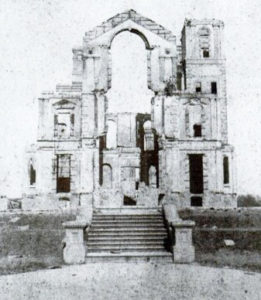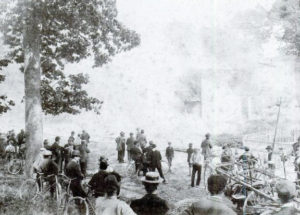
The Waddingham Mansion:
Exactly Where was It?
Part V
See part 1 here.
See part 2 here.
See part 3 here.
See part 4 here.
Though it is difficult to estimate angles on a flat photo, as well as perspective, and Hildrich cannot show his calculations easily, he believes the west front edge of the Mansion was very close to the back of the “brick row” houses from about 655 to 667 Third Ave., the middle 6 to 8 houses. These houses are roughly between 350’ to 500’ from Elm. The east side of the Mansion likely went farther east than the “back alley” that runs behind the entire length of the “brick row,” That alley is behind the back yards and garages about 100’ east of the back of the “brick row.” The Mansion was wide enough to extend into what is now the back yards of some of the houses on the West side of Second Ave.
In later years, that “back alley” of the “brick row” became notorious when it was learned that it was the escape route of West Haven’s infamous “Cat Burglar” of a few decades ago.

If you were a building contractor intent on using the bricks from a ruined mansion [See photo] to build other buildings, you would put your new buildings as near as possible to your source of bricks. This reasonable assumption confirms the calculations of location based on the location of the still-standing Carriage House.
According to the WPA History of West Haven, Thomas H. Linehan, a New Haven casket maker, owned the Mansion property, but did not live in it. It seems reasonable that he bought it at a bargain basement price. Waddingham apparently soured on West Haven, because he could not expand his mansion property beyond what he already had (!), but it is unlikely even a manufacturer would have the money to buy the Waddingham Mansion at market value. Although Waddingham had recovered enough to be worth $4 million when he died in 1899, he had gone bankrupt in 1895. This would explain selling the Mansion for a rock-bottom price in 1895 or so.
The formerly-rented “brick row” houses were put up for sale about 1953, and the Hildrich family bought 665 Third Ave. Interestingly, grandfather Joe Hildrich, the Exalted Ruler who built the current Elks Club, and Aunt “Aunkie” Alma Hildrich, a teacher in Thompson school for many years, used to occasionally talk about the names of the two former landlords, and one was, as Steve Hildrich recalls, Linehan.
Hildrich has no intent to impugn anyone’s reputation. However, after the fire in the Mansion, Mr. Linehan got a free supply of bricks for the “brick row” houses and, by dividing the property, probably about 100 building lots from First Ave. to Fourth Ave., from Elm Street to Wood Street – not bad! In Carole McElrath’s West Haven Revisited, p. 64, the photo of the Mansion after the fire shows that the massive, substantially all-brick structure was still there – but with everything made of wood, etc. burned away.
What is apparently fact is that three properties connected with Wilson Waddingham in West Haven burned down. The unoccupied Mansion burned down under what must be suspicious circumstances on October 16, but the sources disagree whether it was 1902 or 1903. Chief Travis, first chief of the Central Fire District from 1918, was at the fire and said in a statement years later that it was in 1902. In 1906, as noted in the Images of America (series) West Haven also on p. 47, the former caretaker’s cottage of the Mansion burned down. And finally the “Connecticut House” at the great Columbian Exposition of 1892 in Chicago, a major World’s Fair, was, by order of the governor and an appointed committee, removed piece by piece and rebuilt in the Colonial Park area of Ocean Avenue, on a piece of property DONATED BY WILSON WADDINGHAM. In the same book, p. 57, it said that the Red Cross used the building during WW I until a caretaker burning leaves brought it down in 1918. Coincidences? We will probably never know!
Ed. Note: Our thanks to Steve Hildrich for contributing this series to the Historian’s Corner.